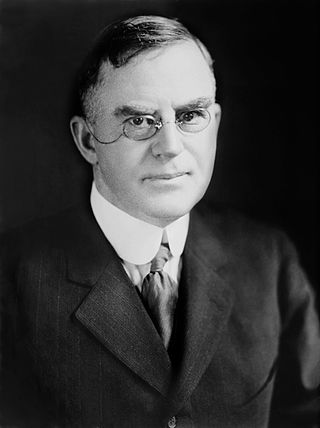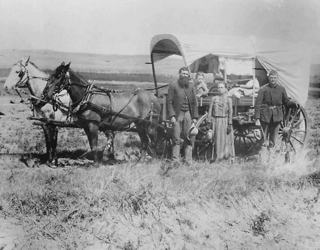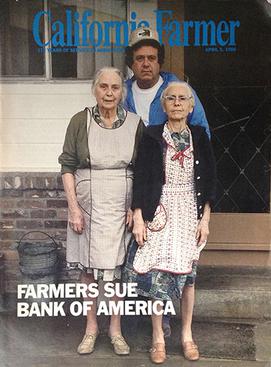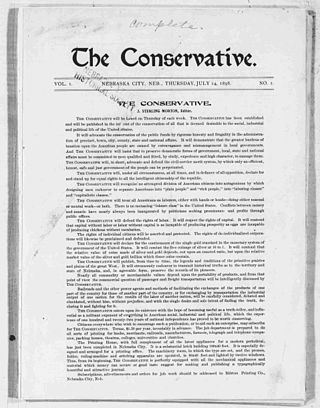
The Daily Nebraskan, established in 1871 as the Monthly Hesperian Student, is the student newspaper of the University of Nebraska–Lincoln. Although many journalism students are on staff, the Daily Nebraskan is independent of the university's College of Journalism and Mass Communications. The newspaper is entirely student-produced and managed, and has a professional general manager, Allen Vaughan, who joined in July 2019 after the retirement of Dan Shattil, who retired in October 2019 after 37 years at the helm.

Henry Cantwell Wallace was an American farmer, journalist, and political activist who served as the secretary of agriculture from 1921 to 1924 under Republican presidents Warren G. Harding and Calvin Coolidge. He was the father of Henry A. Wallace, who would follow in his father's footsteps as secretary of agriculture and later became vice president under president Franklin D. Roosevelt. He was an editor of Wallaces' Farmer from 1916 to 1921.
The Lincoln Journal Star is an American daily newspaper that serves Lincoln, Nebraska, the state capital and home of the University of Nebraska. It is the most widely read newspaper in Lincoln and has the second-largest circulation in Nebraska. The paper also operates a commercial printing unit.

Robert Wilkinson Furnas was the second governor of Nebraska, United States. Born near Troy, Ohio, and orphaned at the age of eight Furnas was a self-made man. He worked as a farmer, printer, tinsmith, insurance salesman, and postmaster all before getting into politics. He married Mary Elizabeth McComas on October 29, 1845, who died in 1897; and his second was Susannah Emswiler Jameson. He had eight children.

Samuel Roy McKelvie was an American politician from the U.S. state of Nebraska. McKelvie served as the 19th governor of Nebraska, from 1919 to 1923. He was also the 13th lieutenant governor of Nebraska, from 1913 to 1915.
Progressive Farmer is an agricultural magazine, published 14 times a year by DTN. The magazine is based in Birmingham, Alabama.
Penton was an information services and marketing company. The company's three largest revenue streams came from events, digital and marketing services. Although Penton had a long history as a trade publisher, in 2015 it reported that 35 percent of its EBITDA derived from digital products, 54 percent from events, and 11 percent from print. The main industry segments served by Penton include agriculture, transportation, natural products/food, infrastructure, and design and manufacturing.
Farm Progress is the publisher of 22 farming and ranching magazines. The company dates back nearly 200 years. Farm Progress Companies is owned by Informa.

The history of the U.S. state of Nebraska dates back to its formation as a territory by the Kansas–Nebraska Act, passed by the United States Congress on May 30, 1854. The Nebraska Territory was settled extensively under the Homestead Act of 1862 during the 1860s, and in 1867 was admitted to the Union as the 37th U.S. state. The Plains Indians are the descendants of a long line of succeeding cultures of indigenous peoples in Nebraska who occupied the area for thousands of years before European arrival and continue to do so today.

The Grand Island Independent is a daily newspaper published in Grand Island, Nebraska.
Southern Progress Corporation, based in Birmingham, Alabama, is a publisher of lifestyle magazines and books owned by IAC's Dotdash Meredith.

California Farmer (1854-2013) was the state of California's leading farm magazine for more than a century.
Artemus Roberts was an architect based in Lincoln, Nebraska. He is perhaps best known as the architect of Fairview House, which was the home of presidential candidate William Jennings Bryan.

The Conservative was a weekly newspaper devoted to the discussion of political, economic, and sociological questions published in Nebraska City, Nebraska, by Julius Sterling Morton.

Milburn Lincoln Wilson was an American Undersecretary of the U.S. Department of Agriculture (USDA) under Presidents Franklin D. Roosevelt and Harry S. Truman under the New Deal and Fair Deal. His main interest was social justice for farmers. He made major contributions to federal agricultural policies, including creating the first domestic allotment plan for the Agricultural Adjustment Act and helping to create the first agricultural commodity programs and for the United States. He also convinced the Millers' National Federation and others to begin enriching bread and cereals.
The Ashland Gazette is a weekly newspaper serving Ashland, Nebraska and surrounding communities of Saunders County, Nebraska.

The Gering Courier is a weekly newspaper serving the Gering, Nebraska, community, currently published in Gering's sister city of Scottsbluff.
The Gibbon Reporter was a newspaper serving Gibbon, Nebraska and surrounding communities of Buffalo County, Nebraska.
The Nebraska Signal is an American weekly newspaper serving Geneva, Nebraska and surrounding Fillmore County, published on Wednesdays.
The Nebraska Capitol Commission is the State of Nebraska's official custodian of the Nebraska State Capitol. The seven-member commission and its corresponding executive agency, the Office of the Nebraska Capitol Commission, serve to assure "the highest quality preservation, restoration, and enhancement of and long-term planning for the State Capitol and capitol grounds for the perpetual use by state government and the enjoyment of all persons."










